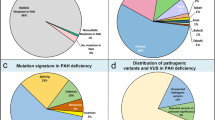Abstract
Intrauterine growth retardation, microcephaly, and developmental delay in two first cousins lead to the recognition of phenylketonuria (PKU) in their mothers, 24- and 23 year-old sisters with blood phenylalanine concentrations of approx. 1.2 mmol/l who had never been treated and had no overt mental retardation. Both mothers were shown to be homozygous for a point mutation leading to an Arg-to-Gln substitution at codon 261 of the phenylalanine hydroxylase gene, a mutation which has been recently identified and tentatively associated with a mild variant of PKU. Our observation suggests that homozygosity for the Arg-261-Gln mutation can indeed result in “mild” PKU with little or perhaps no mental retardation, but also indicates that in such women, who may go unrecognized if not screened for, blood phenylalanine is elevated enough to cause the maternal PKU syndrome in their offspring.
Similar content being viewed by others
Abbreviations
- PAH:
-
phenylalanine hydroxylase
- PKU:
-
phenylketonuria
References
Abadie V, Lyonnet S, Maurin N, Berthelon M, Caillaud C, Giraud F, Mattei JF, Rey J, Rey F, Munnich A (1989) CpG dinucleotides are mutation hot spots in phenylketonuria. Genomics 5:936–939
Brenton DP, Haseler ME (1990) Maternal phenylketonuria. In: Fernandes J, Saudubray JM, Tada K (eds) Inborn metabolic diseases — diagnosis and treatment. Springer, Berlin Heidelberg New York, pp 175–182
Cotton RGH (1990) Heterogeneity of phenylketonuria at the clinical, protein and DNA level. J Inherited Metab Dis 13: 739–750
DiLella AG, Kwok SCM, Ledley FD, Marvit J, Woo SLC (1986) Molecular structure and polymorphic map of the human phenylalanine hydroxylase gene. Biochemistry 25:743–749
DiLella AG, Marvit J, Lidsky AS, Güttler F, Woo SLC (1986) Tight linkage between a splicing mutation and a specific DNA haplotype in phenylketonuria. Nature 322:799–803
DiLella AG, Marvit J, Brayton K, Woo SLC (1987) An amino-acid substitution involved in phenylketonuria is in linkage disequilibrium with DNA haplotype 2. Nature 327:333–336
Drogari E, Beasley M, Smith I, Lloyd JK (1987) Timing of strict diet in relation to fetal damage in maternal phenylketonuria. Lancet II:927–930
Dworniczak B, Aulehla-Scholz C, Horst J (1989) Phenylketonuria: detection of a frequent haplotype 4 allele mutation. Hum Genet 84:95–96
Efron ML (1967) Commentary: classical and mediterranean phenylketonuria. In: Nyhan WL (ed) Amino acid metabolism and genetic variation. McGraw-Hill, New York, pp 115–116
Eisenstein BI (1990) The polymerase chain reaction — a new method of using molecular genetics for medical diagnosis. N Engl J Med 322:178–183
Güttler F, Lou H (1990) Phenylketonuria and hyperphenylalaninemia. In: Fernandes J, Saudubray JM, Tada K (eds) Inborn metabolic diseases — diagnosis and treatment. Springer, Berlin Heidelberg New York, pp 161–174
Güttler F, Ledley FD, Lidsky AS, DiLella AG, Sullivan SE, Woo SLC (1987) Correlation between polymorphic DNA haplotypes at phenylalanine hydroxylase locus and clinical phenotypes of phenylketonuria. J Pediatr 110:68–71
Hanley WB, Clarke JTR, Schoonheyt W (1987) Maternal phenylketonuria (PKU) — a review. Clin Biochem 20:149–156
Kwok SCM, Ledley FD, DiLella AG, Robson KJH, Woo SLC (1985) Nucleotide sequence of a full-length complementary DNA clone and amino acid sequence of human phenylalanine hydroxylase. Biochemistry 24:556–561
Lenke RR, Levy HL (1980) Maternal phenylketonuria and hyperphenylalaninemia — an international survey of the outcome of untreated and treated pregnancies. N Engl J Med 303: 1202–1208
Levy HL, Waisbren S (1983) Effects of untreated maternal phenylketonuria and hyperphenylalaninemia on the fetus. N Engl J Med 309:1269–1274
Lichter-Konecki U, Konecki DS, DiLella AG, Brayton K, Marvit J, Hahn TM, Trefz FK, Woo SLC (1988) Phenylalanine hydroxylase deficiency caused by a single base substitution in an exon of the human phenylalanine hydroxylase gene. Biochemistry 27:2881–2885
Lyonnet S, Caillaud C, Rey F, Berthelon M, Frezal J, Rey J, Munnich A (1989) Molecular genetics of phenylketonuria in Mediterranean countries: a mutation associated with partial phenylalanine hydroxylase deficiency. Am J Hum Genet 44: 511–517
Okano Y, Wang T, Eisensmith RC, Steinmann B, Gitzelmann R, Woo SLC (1990) Missense mutations associated with RFLP haplotypes 1 and 4 of the human phenylalanine hydroxylase gene. Am J Hum Genet 46:18–25
Scriver CR, Kaufman S, Woo SLC (1989) The hyperphenylalaninemias. In: Scriver CR, Beaudet AL, Sly WS, Valle D (eds) The metabolic basis of inherited disease, 6th edn. McGraw-Hill, New York, pp 495–546
Sommer SS, Cassady JD, Sobell JL, Bottema CDK (1989) A novel method for detecting point mutations or polymorphisms and its application to population screening for carriers of phenylketonuria. Mayo Clin Proc 64:1361–1372
Spiegelberg R, Aulehla-Scholz C, Erlich H, Horst J (1989) A β-thalassemia gene caused by a 290-base pair deletion: analysis by direct sequencing of enzymatically amplified DNA. Blood 73:1695–1698
Waisbren SE, Levy HL (1990) Effects of untreated maternal hyperphenylalaninemia on the fetus: further study of families identified by routine cord blood screening. J Pediatr 116:926–929
Wu DY, Ugozzoli L, Pal BK, Wallace RB (1989) Allele-specific enzymatic amplification of β-globin genomic DNA for diagnosis of sickle-cell anemia. Proc Natl Acad Sci USA 86: 2757–2760
Author information
Authors and Affiliations
Rights and permissions
About this article
Cite this article
Superti-Furga, A., Steinmann, B., Duc, G. et al. Maternal phenylketonuria syndrome in cousins caused by mild, unrecognized phenylketonuria in their mothers homozygous for the phenylalanine hydroxylase Arg-261-Gln mutation. Eur J Pediatr 150, 493–497 (1991). https://doi.org/10.1007/BF01958431
Received:
Accepted:
Issue Date:
DOI: https://doi.org/10.1007/BF01958431




